TRPV1 function in mouse colon sensory neurons is enhanced by metabotropic 5-hydroxytryptamine receptor activation
- PMID: 15509739
- PMCID: PMC6730150
- DOI: 10.1523/JNEUROSCI.2639-04.2004
TRPV1 function in mouse colon sensory neurons is enhanced by metabotropic 5-hydroxytryptamine receptor activation
Abstract
Using whole-cell patch-clamp methods, we examined the hypothesis that serotonin [5-hydroxytryptamine (5-HT)] receptor activation enhances TRPV1 function in mouse colon sensory neurons in lumbosacral dorsal root ganglia, which were identified by retrograde labeling with DiI (1,1'-dioctadecyl-3,3,3',3-tetramethlindocarbocyanine methanesulfonate) injected into multiple sites in the wall of the descending colon. 5-HT increased membrane excitability at a temperature below body temperature in response to thermal ramp stimuli in colon sensory neurons from wild-type mice, but not from TRPV1 knock-out mice. 5-HT significantly enhanced capsaicin-, heat-, and proton-evoked currents with an EC50 value of 2.2 microm. 5-HT (1 microm) significantly increased capsaicin-evoked (100 nm) and proton-evoked (pH 5.5) currents 1.6- and 4.7-fold, respectively, and significantly decreased the threshold temperature for heat current activation from 42 to 38 degrees C. The enhancement of TRPV1 by 5-HT was significantly attenuated by selective 5-HT2 and 5-HT4 receptor antagonists, but not by a 5-HT3 receptor antagonist. In support, 5-HT2 and 5-HT4 receptor agonists mimicked the facilitating effects of 5-HT on TRPV1 function. Downstream signaling required G-protein activation and phosphorylation as intracellularly administered GDP-beta-S [guanosine 5'-O-(2-thiodiphosphate], protein kinase A inhibitors, and an A-kinase anchoring protein inhibitor significantly blocked serotonergic facilitation of TRPV1 function; 5-HT2 receptor-mediated facilitation was also inhibited by a PKC inhibitor. We conclude that the facilitation of TRPV1 by metabotropic 5-HT receptor activation may contribute to hypersensitivity of primary afferent neurons in irritable bowel syndrome patients.
Figures

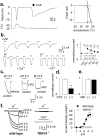


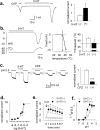
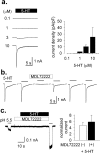
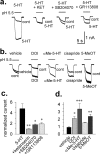
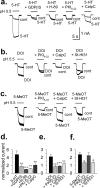
Similar articles
-
Potentiation of transient receptor potential V1 functions by the activation of metabotropic 5-HT receptors in rat primary sensory neurons.J Physiol. 2006 Nov 1;576(Pt 3):809-22. doi: 10.1113/jphysiol.2006.112250. Epub 2006 Aug 10. J Physiol. 2006. PMID: 16901936 Free PMC article.
-
Mouse colon sensory neurons detect extracellular acidosis via TRPV1.Am J Physiol Cell Physiol. 2007 May;292(5):C1768-74. doi: 10.1152/ajpcell.00440.2006. Epub 2007 Jan 24. Am J Physiol Cell Physiol. 2007. PMID: 17251322
-
Visceral hypersensitivity induced by activation of transient receptor potential vanilloid type 1 is mediated through the serotonin pathway in rat colon.Eur J Pharmacol. 2010 Nov 25;647(1-3):75-83. doi: 10.1016/j.ejphar.2010.08.019. Epub 2010 Sep 6. Eur J Pharmacol. 2010. PMID: 20826151
-
The role of the capsaicin receptor TRPV1 and acid-sensing ion channels (ASICS) in proton sensitivity of subpopulations of primary nociceptive neurons in rats and mice.Neuroscience. 2006 May 12;139(2):699-709. doi: 10.1016/j.neuroscience.2005.12.020. Epub 2006 Mar 3. Neuroscience. 2006. PMID: 16515841
-
The mechanosensitivity of mouse colon afferent fibers and their sensitization by inflammatory mediators require transient receptor potential vanilloid 1 and acid-sensing ion channel 3.J Neurosci. 2005 Nov 23;25(47):10981-9. doi: 10.1523/JNEUROSCI.0703-05.2005. J Neurosci. 2005. PMID: 16306411 Free PMC article.
Cited by
-
Extracellular signal-regulated kinases mediate the enhancing effects of inflammatory mediators on resurgent currents in dorsal root ganglion neurons.Mol Pain. 2019 Jan-Dec;15:1744806919837104. doi: 10.1177/1744806919837104. Mol Pain. 2019. PMID: 30803321 Free PMC article.
-
Serotonin increases the functional activity of capsaicin-sensitive rat trigeminal nociceptors via peripheral serotonin receptors.Pain. 2011 Oct;152(10):2267-2276. doi: 10.1016/j.pain.2011.06.002. Epub 2011 Jul 6. Pain. 2011. PMID: 21737202 Free PMC article.
-
Sensitization of TRPV1 by EP1 and IP reveals peripheral nociceptive mechanism of prostaglandins.Mol Pain. 2005 Jan 17;1:3. doi: 10.1186/1744-8069-1-3. Mol Pain. 2005. PMID: 15813989 Free PMC article.
-
Potentiation of transient receptor potential V1 functions by the activation of metabotropic 5-HT receptors in rat primary sensory neurons.J Physiol. 2006 Nov 1;576(Pt 3):809-22. doi: 10.1113/jphysiol.2006.112250. Epub 2006 Aug 10. J Physiol. 2006. PMID: 16901936 Free PMC article.
-
Inflammatory pain: the cellular basis of heat hyperalgesia.Curr Neuropharmacol. 2006 Jul;4(3):197-206. doi: 10.2174/157015906778019554. Curr Neuropharmacol. 2006. PMID: 18615146 Free PMC article.
References
Publication types
MeSH terms
Substances
Grants and funding
LinkOut - more resources
Full Text Sources
Other Literature Sources
Molecular Biology Databases
